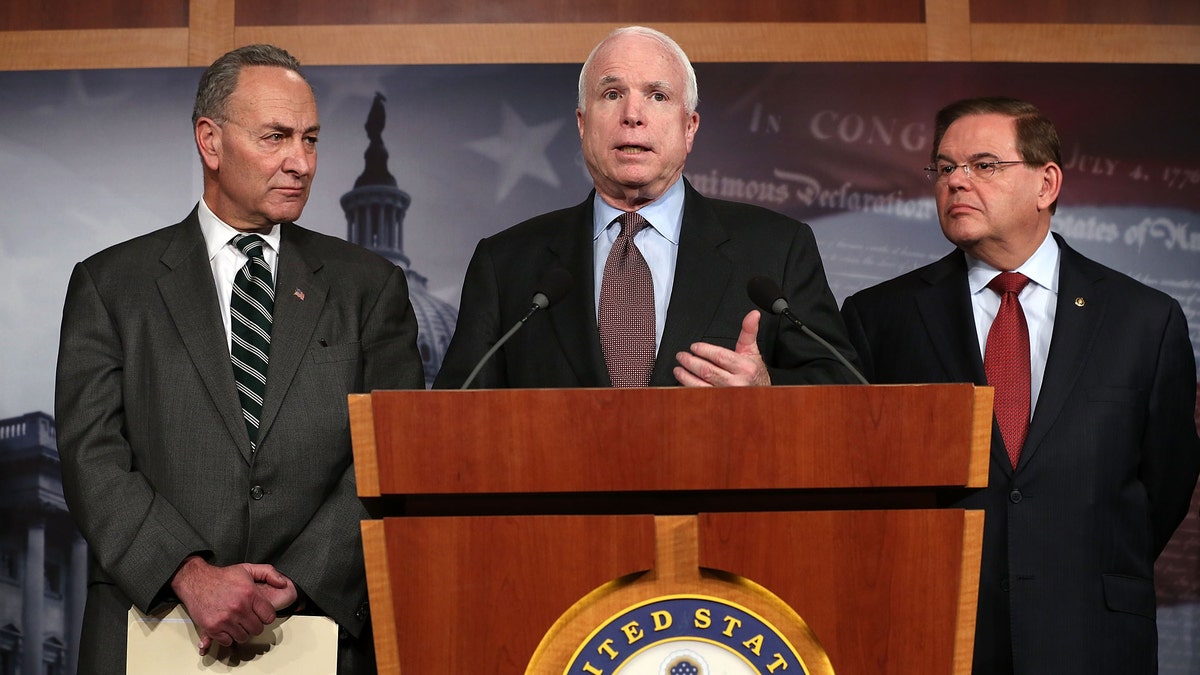
WASHINGTON, DC - JANUARY 28: U.S. Sen. John McCain (R-AZ) (C) speaks as Sen. Charles Schumer (D-NY) (L) and Sen. Robert Menendez (D-NJ) (R) listen during a news conference on a comprehensive immigration reform framework January 28, 2013 on Capitol Hill in Washington, DC. A group of bipartisan senate members have reached to a deal of outlines to reform the nation immigration laws that will provide a pathway for the 11 million illegal immigrants in the country to citizenship. (Photo by Alex Wong/Getty Images) (2013 Getty Images)
The bipartisan Senate immigration reform bill introduced Wednesday shares many similarities with the last sweeping overhaul attempt, in 2007. But there are key differences -- enough, the Senate group behind the bill hopes, to get a measure passed this time around.
The Migration Policy Institute has compiled a preliminary comparison between both bills based on a 17-page outline of the new 844-page proposed law drafted by the "Gang of Eight," the bipartisan coalition of senators that met behind closed doors for weeks to come up with the bill.
Both measures called for eliminating the diversity visa lottery.
The 2007 bill required those seeking a chance to legalize their status to return their countries, but the 2013 one allows them to live and work in the United States under a legal provisional visa. They would be able to become legal permanent residents after more than a decade, given that they meet a strict set of criteria.
The 2007 measure set a cap of 115,000 H1-B visas, for professional, highly-educated people with specialized skills, and kept the rate of such employees at any firm with 50 or more workers at 50 percent. The 2013 measure raised the cap to 110,000, in addition to 25,000 for foreign students who obtain a master’s degree from a U.S. university.
Notably, the new bill allows an H1-B visa holder to change jobs after three months, a point of contention among critics who said that forcing people on employment visas to be tied to a single employer makes that worker vulnerable to exploitation. The current terms of the visa don't allow holders to switch employers.
The old bill added 14,000 Border Patrol agents, and 500 Customs and Border Protection inspectors, in addition to other officers from other agencies. It called for 200 miles of “vehicle barriers” and 370 miles of fencing. It also called for double and triple fencing near San Diego.
The new bill calls for adding 3,500 Customs officers and an “unspecified number” of Border Patrol agents along the border. It also establishes a "Southern Border Fencing Strategy" six months after the bill takes effect and allocates $1.5 billion toward determining where technological reinforcements are needed.
Both bills sought to restrict family preference categories, creating a significant change in the source of immigration – family ties -- to the United States. The old bill eliminated family categories except for spouses and children of legal permanent residents (87,000 visas) and parents of adult U.S. citizens (40,000 visas).
The new one leaves two family categories – unmarried adult children of U.S. citizens and legal immigrants, and married adult children of U.S. citizens.
Most significantly, the new bill scraps the sibling category, one of the most controversial moves in the eyes of many immigration advocacy groups.




